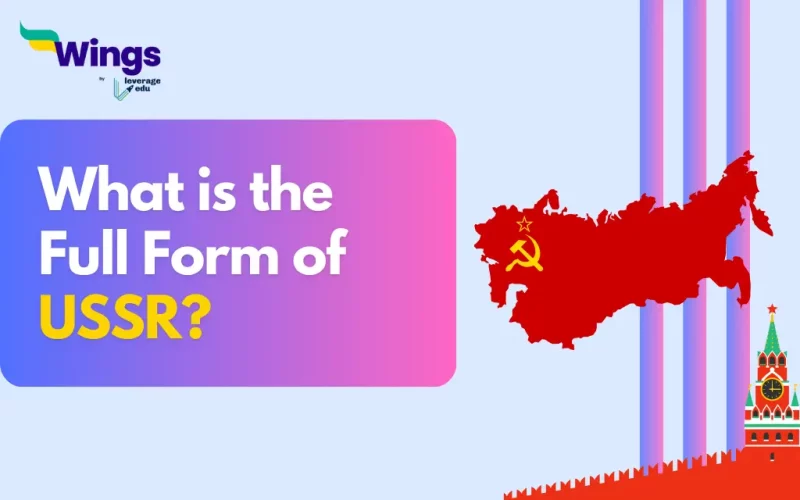The Full Form of the USSR is the Union of the Soviet Socialist Republic. It was a socialist state that existed from 1922 to 1991. The USSR was established on the 30th of December 1922, following the Russian Revolution of 1917. Moreover, it was created as a federation of multiple socialist republics, with Russia being the largest and most influential. Additionally, the USSR was geographically vast, spanning both the continents of Europe and Asia. It covered a significant portion of Eurasia, including Russia, Ukraine, Belarus, the Baltic states, Central Asia, and parts of Eastern Europe.
Also Read: What is the Full Form of TOR?
Leaders of USSR
In addition, the USSR had several leaders throughout its existence. Some of the notable leaders are:
- Vladimir Lenin (1917-1924)
- Joseph Stalin (1924-1953)
- Nikita Khrushchev (1953-1964)
- Leonid Brezhnev (1964-1982)
- Mikhail Gorbachev (1985-1991)
Also Read: What is the Full Form of CIS?
Political and Economic System of the USSR
The USSR had a totalitarian political system characterized by a single-party rule under the Communist Party of the Soviet Union (CPSU). Moreover, the CPSU had absolute control over all aspects of governance, economy, and society.
Furthermore, the USSR implemented a centrally planned economy, where the state owned and controlled most of the means of production. It followed the principles of Marxism-Leninism and aimed to build socialism and eventually communism.
Also Read: What is the Full Form of NAM?
Space Exploration of the USSR
The USSR was the first country to launch an artificial satellite, Sputnik 1, into orbit on the 4th of October 1957. Moreover, it also achieved other significant space milestones, including the first human-made object to reach the Moon (Luna 2) and the first manned spaceflight by Yuri Gagarin in the year 1961.
Culture of USSR
The USSR’s culture was a complex mix of state control and vibrant creativity. Early on, there was experimentation in art and literature. Stalin, however, enforced Socialist Realism, a style portraying a rosy Soviet life. Moreover, censorship limited artistic expression. Despite this, the USSR boasted a high literacy rate and achievements in ballet, cinema, and science fiction. It was a culture of both government control and national pride.
Cold War and the Collapse of the USSR
While learning about the USSR Full Form, we must also learn about its role in the Cold War. The USSR was one of the main participants in the Cold War, a geopolitical rivalry between the Soviet Union and the United States. Additionally, the Cold War was characterized by political, economic, and ideological conflicts between the two superpowers.
The USSR began experiencing economic and political turmoil in the 1980s, hence leading to reforms under Gorbachev’s leadership. However, these reforms ultimately resulted in the dissolution of the USSR on the 26th of December 1991, marking the end of the Cold War era.
Countries under USSR
The Union of Soviet Socialist Republic included the following countries:
| Countries Under USSR | Present Day Countries |
| Russian Soviet Federative Socialist Republic (RSFSR) | Russia |
| Moldavian Soviet Socialist Republic (Moldavian SSR) | Moldovia |
| Georgian Soviet Socialist Republic (Georgian SSR) | Georgia |
| Tajik Soviet Socialist Republic (Tajik SSR) | Tajikistan |
| Lithuanian Soviet Socialist Republic (Lithuanian SSR) | Lithuania |
| Ukrainian Soviet Socialist Republic (UkrSSR) | Ukraine |
| Armenian Soviet Socialist Republic (Armenian SSR) | Armenia |
| Kyrgyz Soviet Socialist Republic (Kyrgyz SSR) | Kyrgyzstan |
| Uzbek Soviet Socialist Republic (Uzbek SSR) | Uzbekistan |
| Estonian Soviet Socialist Republic (Estonian SSR) | Estonia |
| Turkmen Soviet Socialist Republic (Turkmen SSR) | Turkmenistan |
| Latvian Soviet Socialist Republic (Latvian SSR) | Latvia |
| Azerbaijani Soviet Socialist Republic (Azerbaijan SSR) | Azerbaijan |
| Kazakh Soviet Socialist Republic (Kazakh SSR) | Kazakhstan |
| Byelorussian Soviet Socialist Republic (Belorussian SSR) | Belarus |
Popular Full Forms
We hope this blog has helped you understand the USSR Full Form and everything related to it. If you want to know more, find the full forms list on our blog. In the world of short forms, you can rely on the Leverage edu page to know about more full forms like this! Connect with us study abroad experts to achieve your international dream today!
 One app for all your study abroad needs
One app for all your study abroad needs













